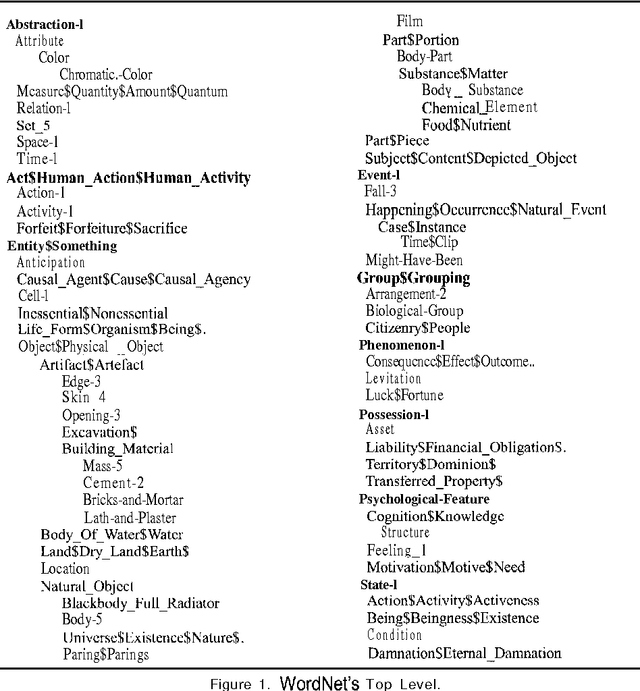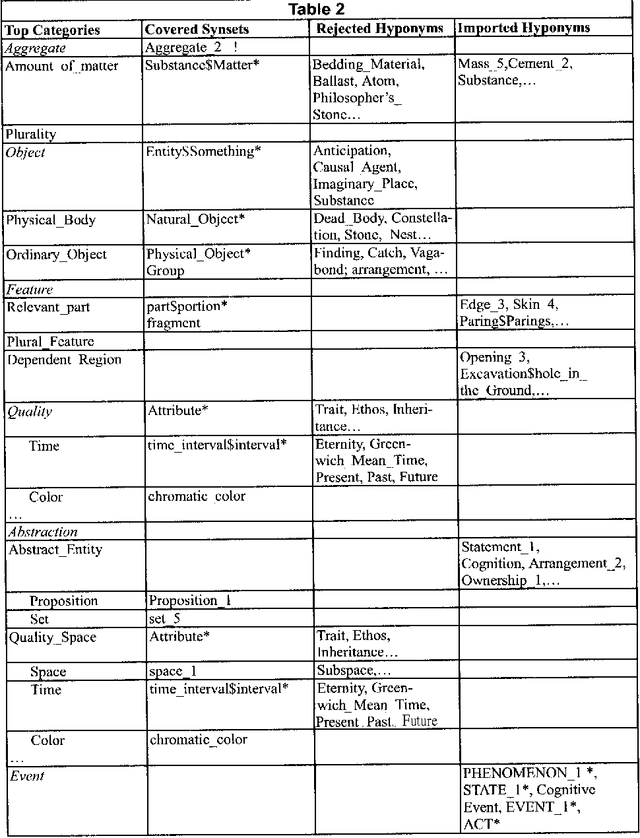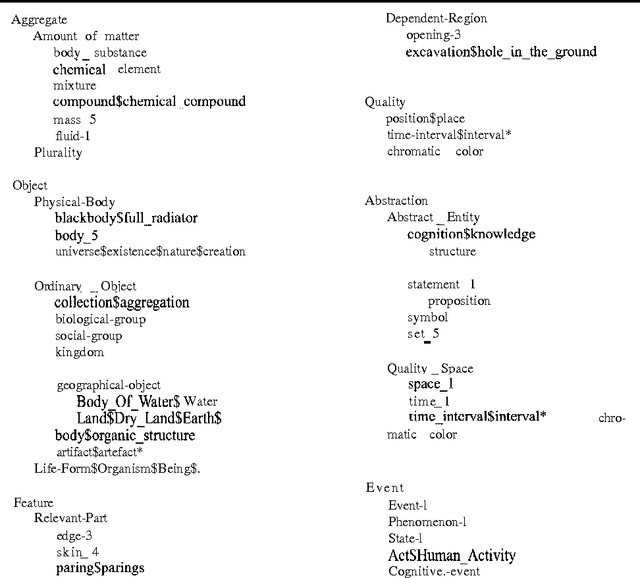Nicola Guarino
LADSEB-CNR, Padova, Italy
DOLCE: A Descriptive Ontology for Linguistic and Cognitive Engineering
Aug 03, 2023Abstract:DOLCE, the first top-level (foundational) ontology to be axiomatized, has remained stable for twenty years and today is broadly used in a variety of domains. DOLCE is inspired by cognitive and linguistic considerations and aims to model a commonsense view of reality, like the one human beings exploit in everyday life in areas as diverse as socio-technical systems, manufacturing, financial transactions and cultural heritage. DOLCE clearly lists the ontological choices it is based upon, relies on philosophical principles, is richly formalized, and is built according to well-established ontological methodologies, e.g. OntoClean. Because of these features, it has inspired most of the existing top-level ontologies and has been used to develop or improve standards and public domain resources (e.g. CIDOC CRM, DBpedia and WordNet). Being a foundational ontology, DOLCE is not directly concerned with domain knowledge. Its purpose is to provide the general categories and relations needed to give a coherent view of reality, to integrate domain knowledge, and to mediate across domains. In these 20 years DOLCE has shown that applied ontologies can be stable and that interoperability across reference and domain ontologies is a reality. This paper briefly introduces the ontology and shows how to use it on a few modeling cases.
* 25 pages, 7 figures
Semantics, Ontology and Explanation
Apr 21, 2023



Abstract:The terms 'semantics' and 'ontology' are increasingly appearing together with 'explanation', not only in the scientific literature, but also in organizational communication. However, all of these terms are also being significantly overloaded. In this paper, we discuss their strong relation under particular interpretations. Specifically, we discuss a notion of explanation termed ontological unpacking, which aims at explaining symbolic domain descriptions (conceptual models, knowledge graphs, logical specifications) by revealing their ontological commitment in terms of their assumed truthmakers, i.e., the entities in one's ontology that make the propositions in those descriptions true. To illustrate this idea, we employ an ontological theory of relations to explain (by revealing the hidden semantics of) a very simple symbolic model encoded in the standard modeling language UML. We also discuss the essential role played by ontology-driven conceptual models (resulting from this form of explanation processes) in properly supporting semantic interoperability tasks. Finally, we discuss the relation between ontological unpacking and other forms of explanation in philosophy and science, as well as in the area of Artificial Intelligence.
Conceptual Analysis of Lexical Taxonomies: The Case of WordNet Top-Level
Sep 11, 2001


Abstract:In this paper we propose an analysis and an upgrade of WordNet's top-level synset taxonomy. We briefly review WordNet and identify its main semantic limitations. Some principles from a forthcoming OntoClean methodology are applied to the ontological analysis of WordNet. A revised top-level taxonomy is proposed, which is meant to be more conceptually rigorous, cognitively transparent, and efficiently exploitable in several applications.
Some Ontological Principles for Designing Upper Level Lexical Resources
Sep 09, 1998



Abstract:The purpose of this paper is to explore some semantic problems related to the use of linguistic ontologies in information systems, and to suggest some organizing principles aimed to solve such problems. The taxonomic structure of current ontologies is unfortunately quite complicated and hard to understand, especially for what concerns the upper levels. I will focus here on the problem of ISA overloading, which I believe is the main responsible of these difficulties. To this purpose, I will carefully analyze the ontological nature of the categories used in current upper-level structures, considering the necessity of splitting them according to more subtle distinctions or the opportunity of excluding them because of their limited organizational role.
* 8 pages - gzipped postscript file - A4 format
 Add to Chrome
Add to Chrome Add to Firefox
Add to Firefox Add to Edge
Add to Edge